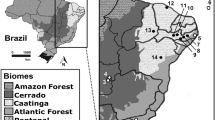Summary
The oviposition sites and larval cycle of the African species of Lissocephala, the most primitive genus of Drosophilidae, are described here for the first time. The genus Lissocephala has achieved a novel adaptive direction in the Ethiopian region. All known African species are strictly specialized on Ficus. This species diversity suggests that ecological transfer to Ficus preceded the Lissocephala radiation. Lissocephala larvae breed inside immature figs. The eggs are laid in or near the fig ostiole. First instar larvae enter the fig receptacle though the ostiolar entrance is constantly closed by firmly imbricating bracts. Third instar larvae leave the fig by crawling out between the ostiolar bracts, and drop to the soil where they pupate. Thus Lissocephala species larvae breed inside a sheltered microhabitat, since the numerous other sympatric sycophagous Drosophilids do not have the ability to colonize immature figs. Other groups of Drosophilid species breed successively on the ripening exocarp of the fig following the successive microbial states of the fig. The possibility of coevolution of Lissocephala species, Ficus species and pollinator fig wasp species is discussed. Selection for avoidance of competition increased Lissocephala species' efficiency in exploiting unutilized immature figs and then provided a conspicuous niche separation which contributed to species packing on figs.
Similar content being viewed by others
References
Burla, H.: Zur Kenntnis der Drosophiliden der Elfenbeinküste. Rev. Suisse Zool. 61, 1–218 (1954)
Buruga, J.H., Olembo, R.J.: Plant food preferences of some sympatric Drosophilids of tropical Africa. Biotropica 3 (2), 151–158 (1971)
Carson, H.L.: Three flies and three Islands: Parallel evolution in Drosophila. Proc. Natl. Acad. Sci. USA 71, 3517–3521 (1974)
Carson, H.L., Wheeler, M.R.: A new crab fly from Christmas Island, Indian Ocean (Dipt: Drosophilidae). Pacific Insects 15 (2), 199–208 (1973)
Galil, J., Eisikowitch, D.: On the pollination ecology of Ficus sycomorus in East Africa. Ecology 49, 259–269 (1968)
Hill, D.S.: Figs (Ficus spp.) and fig-wasps (Chalcidoidea). J. Nat. Hist. 1, 413–434 (1967)
Hutchinson, J., Dalziel, J.M.: Flora of West tropical Africa. The crown agents for the colonies. London: 1936
Lachaise, D.: Les Drosophilidae des savanes préforestières de la région tropicale de Lamto (Côte d'Ivoire). I. Isolement écologique des espèces affines et sympatriques; rythmes d'activité saisonnière et circadienne; rôle des feux de brousse. Ann. Univ. Abidjan VII, 7–152 (1974a)
Lachaise, D.: Les Drosophilidae des savanes préforestières de la région tropicale de Lamto (Côte d'Ivoire). V. Les régimes alimentaires. Ann. Soc. Entomol. Fr. 10, 3–50 (1974b)
Lachaise, D.: Les Drosophilidae des savanes préforestières de Lamto (Côte d'Ivoire). II. Le peuplement du Palmier Rônier. Ann. Univ. Abidjan VIII, 223–280 (1975)
Lachaise, D.: Les Drosophilidae des savanes préforestières de Lamto (Côte d'Ivoire). IV. Synécologie fonctionnelle du peuplement de Ficus capensis. Bull. Ecol. 7, 79–104 (1976)
Malloch, J.R.: Exotic Muscaridae (Dipt.) 27. Ann. Mag. Natur. Hist., Ser. 10, 4, 249–257 (1929)
Miller, M.W., Phaff, H.J.: Successive microbial populations in Calimyrna Figs. Appl. Microbiol. 10, 394–400 (1962)
Phaff, H.J., Miller, M.W.: A specific microflora associated with the Fig wasp, Blastophaga psenes Linnaeus. J. Insect Pathol. 3, 233–243 (1961)
Pielou, E.C.: Ecological diversity. New York: Wiley 1975
Ramirez, B.W.: Taxonomic and biological studies of neotropical Fig wasps (Hymenoptera: Agaonidae). The University of Kansas Science Bulletin, XLIX, 1, 1–44 (1970)
Ramirez, B.W.: Coevolution of Ficus and Agaonidae. Ann. Missouri. Bot. Gard. 61, 770–780 (1974)
Richardson, R.H., Smouse, P.E.: Ecological specialization of Hawaiian Drosophila. II. The community matrix, ecological complementation and phyletic species packing. Oecologia (Berl.) 22, 1–13 (1975)
Throckmorton, L.H.: The phylogeny, ecology, and geography of Drosophila. Handbook of genetics, Vol. 3, Invertebrates of genetic interest, Vol. 17, pp. 421–469 (R. King, ed.). New York: Plenum Publishing Corporation 1975
Wheeler, M.R., Takada, H.: Insects of Micronesia (Dipt. Drosophilidae). Insects of Micronesia 14, 163–242 (1964)
Wiebes, J.T.: Taxonomy and host preferences of Indo-Australian fig wasps of the genus Ceratosolen (Agaonidae). Tijdschr. Entomol. 106, 1–112 (1963)
Wiebes, J.T.: Phylogenetic specificity of Figs and Fig wasps. Pollination and dispersal (N.B.M. Brantjes, ed.). Dept. of Botany, Nijmegen (1973)
Author information
Authors and Affiliations
Rights and permissions
About this article
Cite this article
Lachaise, D. Niche separation of African Lissocephala within the Ficus Drosophilid community. Oecologia 31, 201–214 (1977). https://doi.org/10.1007/BF00346921
Received:
Issue Date:
DOI: https://doi.org/10.1007/BF00346921




